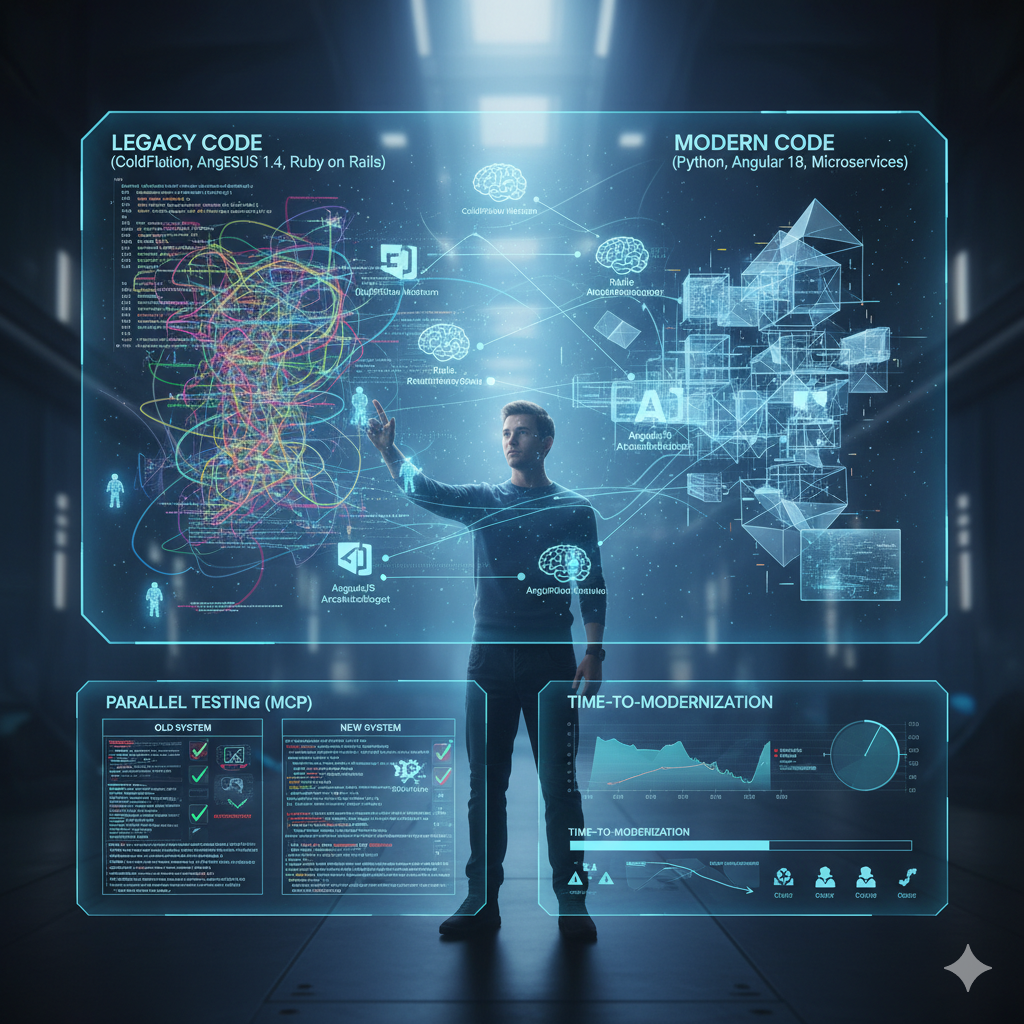September 24, 2025
If you’ve ever stared into the abyss of a 20-year-old ColdFusion codebase, you know a special kind of dread. For years, these systems were untouchable—too critical to fail, too complex to modernize. The conventional wisdom was a grim choice between doing nothing or betting the farm on a multi-year rewrite.
Today, AI has changed the game. But it’s crucial to understand that not all AI approaches are equal. The off-the-shelf, general-purpose models are a helpful starting point, but when faced with the tangled, idiomatic reality of a legacy system, they often fall short, producing a mess of “hallucinated” or non-functional code.
The real breakthrough comes from a more disciplined approach: the use of highly specialized models, fine-tuned for the specific nuances of each programming language and architectural pattern. This is the difference between a blunt instrument and a surgical tool, and it’s central to a successful modernization strategy.
The Art of the Rewrite: Moving Beyond Translation to Comprehension
The biggest fear in any rewrite is losing the nuanced business logic accumulated over decades. We recently tackled a massive ColdFusion application where a generic AI would have attempted a crude, literal translation of CFML tags.
A more specialized model, however, can do something else entirely. Because it has been fine-tuned on the specifics of the ColdFusion architecture—its quirks, common patterns, and anti-patterns—it doesn’t just translate the code; it comprehends its intent. It can identify and extract the underlying business rules buried in CFQUERY loops and re-engineer them as clean, secure, and performant methods in a modern Python and Angular/Javascript application.
We’ve seen the same with sprawling AngularJS 1.4 front-ends. A model that deeply understands the soul of $scope, directives, and the digest cycle can generate a functionally identical component in Angular 18, preserving the application’s behavior with proper state management.
Beyond Generalization: The Power of Context-Aware Models
So, what differentiates this specialized approach? It’s the shift from general-purpose knowledge to domain-specific expertise. An off-the-shelf LLM is like a tourist with a phrasebook—it can ask where the library is, but it can’t understand poetry. A specialized model, however, becomes a digital native of the technology it’s working with.
Achieving this requires meticulously tuning models on very specific types of data:
- Architectural Context Models: For a language like ColdFusion, an effective model needs to be trained not just on syntax, but on two decades of documentation, forum posts, and real-world applications to understand the why behind the code.
- Idiomatic Pattern Models: To refactor a Ruby on Rails application, a model must be an expert in the “Rails way,” capable of identifying bloated controllers and non-idiomatic code that a generalist AI would miss.
- Framework Evolution Models: For something like AngularJS, the AI must be an “archaeologist,” specifically trained to navigate the complexities of a dead-end framework and map its concepts to modern paradigms.
This deep focus on context is what separates a predictable, architect-led modernization from an automated mess.
Agentic Co-pilots, Powered by Expertise
This specialized knowledge is what elevates AI from a simple tool to an Agentic Co-pilot. When an engineer assigns a task like, “Refactor this Rails controller,” the agent isn’t powered by a generic model. It’s guided by a model fine-tuned on Rails best practices. It knows the pitfalls, applies TDD principles to write meaningful tests, and submits a pull request that a senior developer can actually approve.
Gaining Confidence with Intelligent Parallel Testing
This expertise extends to the validation process. When using tools via Model Context Protocol (MCP) to run the old and new systems side-by-side, the AI doesn’t just look for surface-level differences. Specialized models know the specific edge cases and failure points of the legacy technology. They generate a barrage of intelligent tests designed to probe those weak spots, ensuring that the new system is not just a copy, but a truly resilient and faithful successor.
The New Reality
The conversation around application modernization has shifted. It’s no longer a question of if AI can help, but how it should be applied. The most successful outcomes—slashed timelines, reduced costs, and de-risked projects—don’t come from a generic algorithm. They emerge from a deep, expert-level understanding of technology, encoded into the very DNA of the AI models. That is the capability that truly transforms the modernization process.






